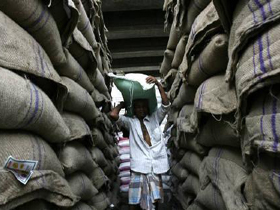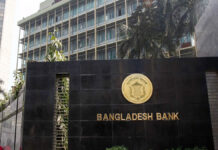Locally set up ‘community-based rice banks’ have been found to help marginal and poor communities living in the Chittagong Hill Tracts address food shortages during lean periods.
Killyamura Bangali para and Tripura para comprising 75 households of Bangali and Tripura communities are located on a shoreline of Kaptai Lake at Balukhali, nearly five kilometers away from Rangamati district town. The members of the two communities jointly set up a rice bank with financial support from the United Nations Development Programme (UNDP).
Abul Kalam, a member of Killyamura Bangali para, said their livelihoods center fishing and traditional jum cultivation as there is not enough arable land.
“The Fisheries Department imposes ban on fishing in Kaptai Lake for three months starting from May each year to increase fish production in the lake. So, we face hard time during this period and borrow rice from the rice bank, which we set up to address food crisis,” he said.
All households of a para (roughly a neighbourhood) contribute a fixed amount of rice after jum harvesting to the rice bank. When the households face food crisis during lean period, they borrow rice from the rice bank and reimburse the rice to the bank after another jum harvesting.
Killyamura Bangali para Development Committee established a rice bank costing Tk 14 lacs financed by the UNDP.
Sandhaya Rani Tripura, a household head of Tripura para, said the Para Development Committee has already distributed rice among the households of the two communities faced with shortages in the ongoing lean period while the fishing ban is in place.
“All households of the para are food-secure following distribution of rice from the bank. It has allowed them to easily address this lean period,” she said.
Sandhaya Rani further said that before the rice bank was built, they had to borrow money from usurers at high interest rates to buy food grains. “But now, we can borrow rice from our own rice bank, at low interest. In the last lean season, we mitigated our food crisis and this will continue in the future,” Sandaya said.
A total of 1708 rice banks have already been created in the three hilly districts – Rangamati, Bandarban and Khagrachari – under the Community Empowerment and Economic Development Project financed by Chittagong Hill Tracts Development Facility (CHTDF) programme of UNDP. Every para has a rice bank.
Biplab Chakma, chief of Community Empowerment, CHTDF programme, said the UNDP in conducting its programme in CHT found that households of the remote and hilly areas suffer from food crisis for two-and-half months on average each year.
“Earlier, we identified a best practice in many communities in Bandarban that they store food grains to cope with crisis period and later we introduced rice banks all over the region starting in 2005,” he said.
Biplab said they helped the community set up a 600 harhi capacity (6000 kilogram) rice bank in every para, providing 3,000 kilogram of rice to every rice bank as a starting grant to launch the bank. Later, the households refunded it.
The annual survey conducted by CHTDF in 2012 shows that the Para Development Committee increased each unit’s capacity to manage their rice banks within their communities.
A total of 29093 households were able to borrow 3,365,000 kg rice with support of CHTDF in a prior period to meet food shortage, revealing the increased management capacity of the committee to handle both demand and supply sides of rice in the communities.
Source: UNConnect










